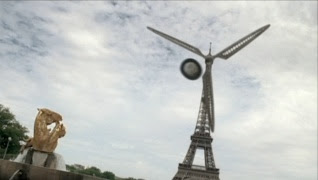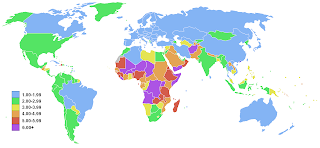 In a misguided attempt to know what is happening in the world, I often make the mistake of looking to satellite television. There is an annoying television spot that is aired repeatedly by Chevron, using the obscene profits that they don't squirrel away as the middlemen for Iran, Saudi Arabia, Russia, Venezuela, and Dubai, to brainwash the public and protect their oil racket. It attempts to ridicule wind energy in a mild-mannered, condescending tone, with an image of the Eiffel Tower converted into a heavy-looking wind turbine, as a man's bowler hat blows away into the wind. It is mostly visual and musical, but here is the script:
In a misguided attempt to know what is happening in the world, I often make the mistake of looking to satellite television. There is an annoying television spot that is aired repeatedly by Chevron, using the obscene profits that they don't squirrel away as the middlemen for Iran, Saudi Arabia, Russia, Venezuela, and Dubai, to brainwash the public and protect their oil racket. It attempts to ridicule wind energy in a mild-mannered, condescending tone, with an image of the Eiffel Tower converted into a heavy-looking wind turbine, as a man's bowler hat blows away into the wind. It is mostly visual and musical, but here is the script:
As a source of energy, wind power alone can't do it all.
Because just to power a city like Paris would take 20,000 turbines.
We believe that meeting all our energy needs will take innovation,
conservation...and collaboration. Will you join us?
You can view the spot(s)
here. The script and the source of their data is listed
here as:
Source:
735 Wind Turbines in Japan produce 0.9 billion kWh of power with a 15% load factor, 1.8 billion with a 30% factor, or 3.0 billion with a 50% factor. Paris' 11.5 million people consume 90 billion kWh annually. 90 billion kWh / 0.9 billion kWh = 100; 90/1.8= 50; 90/3.0= 30. So somewhere between 30 & 100 times the 735 wind turbines, or between 22000 & 73000 wind turbines would be needed to power Greater Paris (Ile de France).
Chevron is an honest broker for the analysis of the potential of wind energy, just as people who raise cattle and sell beef would be excellent consultants regarding the nutritional value of fish. Likewise, to learn more about the effects of sexual abstinence, consult a prostitute.
This seemed like a silly ad to me, because 20,000 wind turbines is not a terribly huge number, and might fit in a rather compact square of land, depending on how much space each one requires. I decided to look into the spacing requirements for wind turbines a little more closely.
According to this
pdf, from PowerNaturally.com, a wind power project could use as much as 59 acres per turbine (39 acres per megawatt of generating capacity) in plans which allow for multidirectional sources of wind, or 26.7 acres per turbine (17.8 acres per megawatt) in sites that have a consistent wind direction. If we trust the Chevron numbers as for the number of turbines required, and make the assumption that the turbines in Japan are similar to the ones described in the wind power pdf, the 22,000 to 73,000 wind turbines that Chevron says greater Paris needs for its 11 million people would require (22,000 X 59) 1,180,000 acres of land, or in the worst case, (73,000 X 59) 4,307,000 acres of land. That is equal to a range from 4775 square km to 17,000 square km. How much is that? The area of France, not counting the offshore coastal areas which would be most optimal for wind energy, is 674,843 square kilometers. The area required would be about seven-tenths of one percent of France's land area, or up to 2.5% in the case for which turbines, due to the lack of a consistent wind direction, need to be located farther apart to reduce turbulence. Ninety-five percent of the land on a wind farm remains available for other uses, such as grazing cattle to produce milk and cheese. If these wind farms were located offshore, the base of the support structure could also be extracting wave energy, tidal energy, or could serve as an artificial reef to increase marine resources. Scaling up by a factor of 5 or 6 to cover supply all of France's population would use only about 10% of the land, or an offshore area of equal size. Although it is unlikely that France would try to provide all of its energy from wind, wind is not as unreliable as it is made out to be, if a long network of wind generators were to networked together along a long coastline, much of the network is certain to be producing power at any given time.
This is all very back-of-the-envelope, but I don't think it is too far off the mark.
By the way, France already produces
over 90% of its electricity from carbon-free sources (mostly nuclear plus hydroelectric). (Tip to
M. Fuhrer, who referred to this ad when it first aired in… October '05? No wonder I'm so sick of it.) It also seems that this ad is aired internationally, in
Russia as well as the US and Japan.
Chevron and their bosom buddies should spend less time and money at the quixotic task of attacking wind (and windmills) and get to work building wind turbines. It isn't quite as easy as the traditional fire-monkey tactic of getting control of flammable substances which shoot out of the ground at high pressure, but it is good, honest, carbon-free work. Builds character, too.
Corporate irresponsibility will make it harder for a responsible government --in the event one should ever come to power -- to avoid the step of nationalizing the oil companies and seizing their assets to use in the crash global program to deploy the earth's human capital and labor toward a sustainable energy model for the civilization.


























